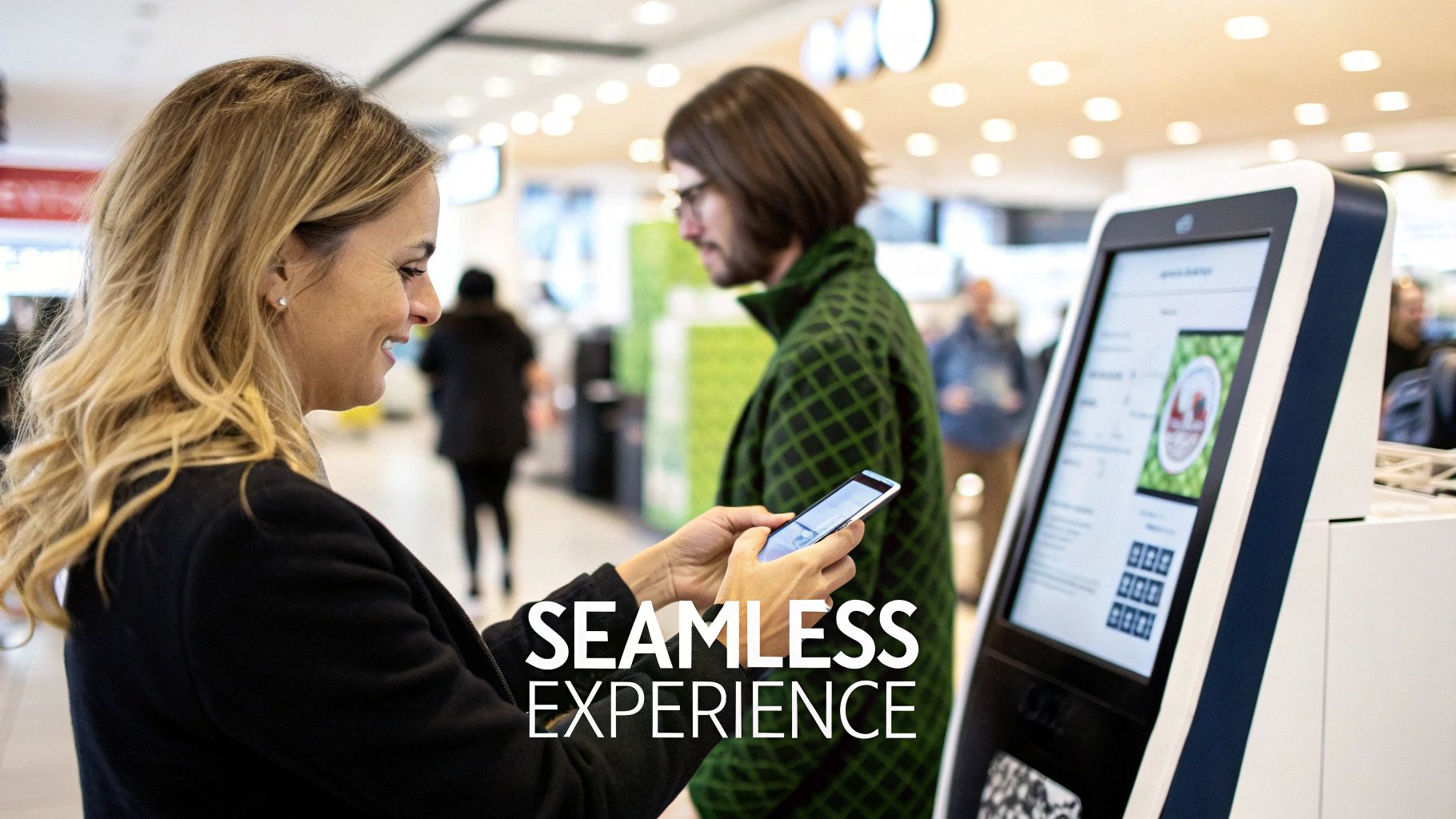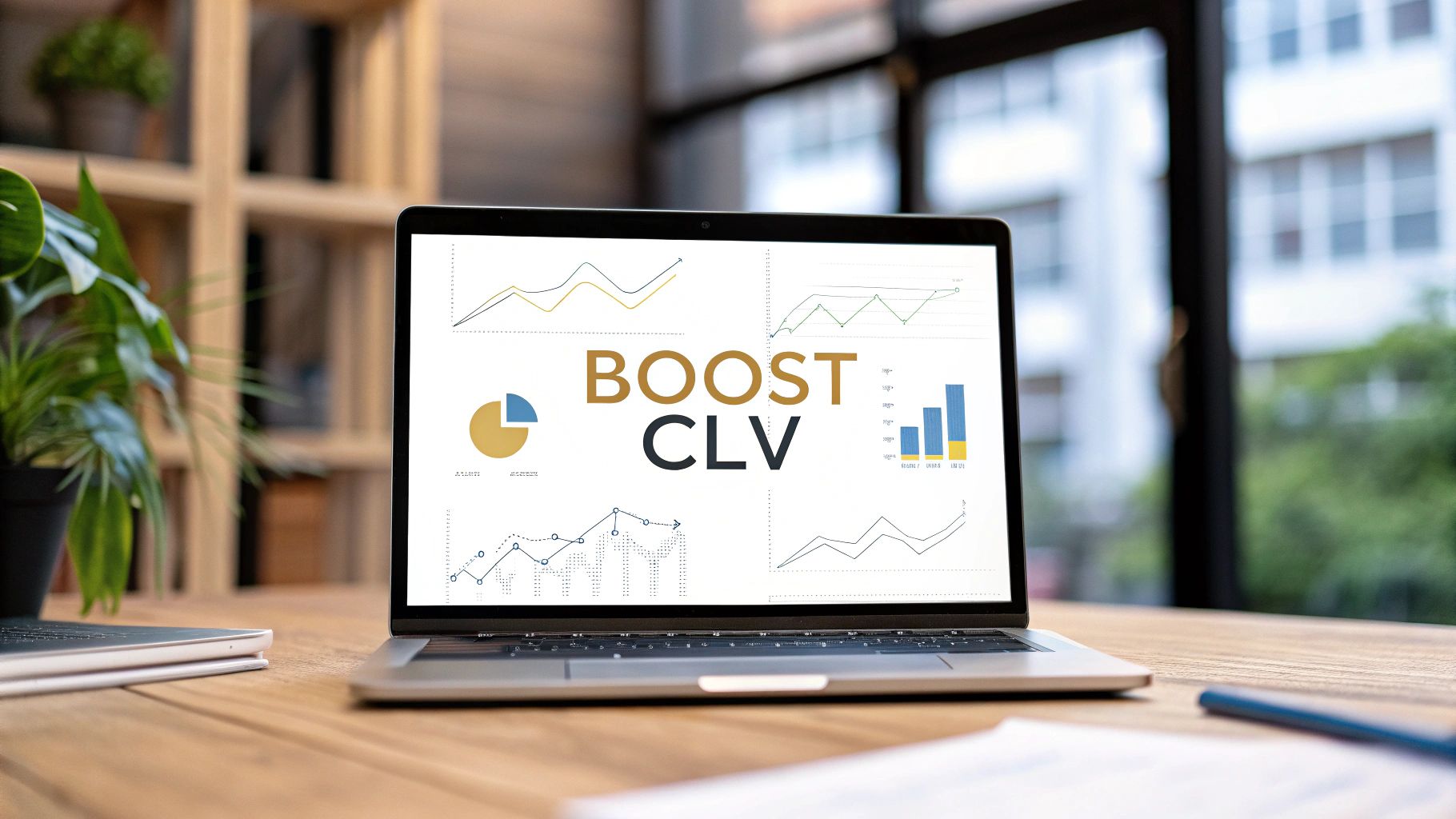In the competitive SaaS landscape, acquiring new customers is only half the battle. True, sustainable growth lies in maximizing the value of the customers you already have. This article focuses on the ultimate metric for long-term success: Customer Lifetime Value (CLV). We'll move beyond generic advice and dive into eight proven, actionable strategies specifically designed for SaaS businesses to boost CLV.
At the core of increasing customer lifetime value is the ability to establish and maintain strong relationships. Learning the specific strategies for how to build customer trust is a foundational step that underpins the effectiveness of every tactic discussed here.
This guide provides a comprehensive blueprint for turning happy customers into powerful growth advocates and optimizing your product experience for immediate value realization. We'll explore how modern platforms can simplify the implementation of native affiliate programs, a key lever in extending customer relationships and driving recurring revenue. Prepare to learn how to build deeper loyalty, reduce churn, and systematically increase customer lifetime value, securing your company's future in 2025 and beyond.
1. Strategy 1: Launch a Native Referral & Affiliate Program
Transform your most satisfied customers into a powerful growth engine by launching a referral and affiliate program that lives directly within your SaaS platform. Unlike clunky, third-party tools that disrupt the user experience, a native program embeds seamlessly into your application’s interface. This makes it effortless for customers to share and for promoters to track their success.
This strategy is foundational for sustainable growth because it creates a powerful, self-reinforcing loop. Happy customers refer new users, who are often a better fit and more likely to stick around, thus having a higher lifetime value. This approach not only lowers your customer acquisition cost (CAC) but also directly helps to increase customer lifetime value across your entire user base.
Why It Works
A native program leverages trust and reduces friction. When a recommendation comes from a peer, it carries more weight than traditional advertising. By making the referral process a natural part of the product experience, you maximize participation.
- Dropbox famously offered extra storage for referrals, leading to a 3900% growth in just 15 months.
- Morning Brew scaled its newsletter to millions of subscribers with a tiered reward system that incentivized sharing.
- SaaS platforms using tools like Refgrow can embed a complete affiliate dashboard with a single line of code, connecting them to a network of promoters instantly.
How to Implement This Strategy
To execute this effectively, focus on seamless integration and clear incentives.
- Make sharing frictionless: Enable users to share their unique referral link in just one or two clicks from their dashboard.
- Offer two-sided rewards: Motivate both parties by giving a discount to the new user and a credit or commission to the referrer.
- Provide resources: Equip your affiliates with pre-made marketing materials, such as banners, email copy, and social media posts, to make promotion easy.
For those looking to dive deeper into launching and succeeding with an affiliate program, particularly within popular platforms, you might find this complete guide to the TikTok Affiliate Programme valuable. Implementing a well-structured program is one of the most direct ways to turn customer loyalty into a predictable revenue stream.
2. Strategy 2: Implement Proactive Customer Success
Shift your support model from reactive problem-solving to proactive success management. A dedicated customer success strategy focuses on ensuring customers consistently achieve their desired outcomes with your product. This means moving beyond just answering support tickets and instead actively guiding users, anticipating their needs, and helping them realize the full value of your SaaS platform.

This approach is crucial because it directly addresses the root causes of churn. By ensuring customers are successful, you make your product indispensable to their workflow. This not only prevents them from leaving but also identifies prime opportunities for upselling and cross-selling. A strong customer success function is one of the most effective ways to increase customer lifetime value by transforming users into long-term partners.
Why It Works
Proactive support builds deep, lasting relationships and demonstrates a genuine investment in your customers' goals. When users feel you are a partner in their success, their loyalty and advocacy grow exponentially. This strategy turns customer service from a cost center into a powerful revenue and retention driver.
- Salesforce pioneered its Customer Success Platform, which helped reduce churn by an average of 25% for its enterprise clients.
- HubSpot's customer success teams proactively contact users who show signs of decreased engagement, offering guidance to get them back on track.
- Box, with the help of Gainsight's customer success software, was able to reduce its customer churn rate by 30%, proving the model's ROI.
How to Implement This Strategy
Executing a successful customer success strategy requires a data-driven and empathetic approach.
- Implement customer health scoring: Create a system that tracks key product usage metrics, support tickets, and satisfaction scores to identify at-risk accounts before they churn.
- Develop a comprehensive onboarding program: Guide new users through a structured onboarding process with clear milestones that lead them to their first "aha!" moment quickly.
- Automate success milestones: Use automated workflows to celebrate user achievements, suggest next steps, and offer relevant resources as they reach key points in their journey.
For a deeper look into a variety of powerful retention techniques, check out this guide to SaaS customer retention strategies. Investing in your customers' success is a direct investment in your own long-term growth.
3. Loyalty Programs and Rewards Systems
Implement a structured loyalty program to systematically reward customers for their continued business and engagement. Far more than a simple discount, a well-designed rewards system creates powerful emotional and financial incentives for customers to remain with your brand. By offering points, tiered benefits, and exclusive access, you transform transactional relationships into long-term partnerships.
This strategy is a direct lever to increase customer lifetime value by encouraging repeat purchases and deeper product adoption. When customers feel recognized and rewarded, their loyalty solidifies, making them less susceptible to competitor offers. This not only secures future revenue but also turns your customer base into a predictable and stable asset, which is crucial for sustainable SaaS growth.
Why It Works
Loyalty programs tap into fundamental human psychology: the desire for recognition, status, and reward. They gamify the customer journey, making continued engagement feel valuable and fun. By tracking behavior, you can also personalize offers, making customers feel understood.
- Starbucks Rewards is a masterclass, with its 24+ million members driving over 50% of the company's revenue through repeat business.
- Amazon Prime members spend more than double what non-members do, proving that bundling exclusive benefits with a membership fee creates immense loyalty.
- Sephora's Beauty Insider program is so effective that an estimated 90% of its sales come from loyalty members, demonstrating the power of a tiered system.
How to Implement This Strategy
To build a program that resonates, focus on simplicity, value, and personalization. The goal is to make participation feel effortless and the rewards genuinely desirable.
- Make it simple to join and track: Customers should understand the rules and see their progress easily within their account dashboard. Avoid complex point calculations.
- Offer meaningful, tiered rewards: Go beyond discounts. Offer early access to new features, exclusive content, or dedicated support channels. The rewards should align with what your customers value most.
- Personalize the experience: Use customer data to tailor offers. If a user frequently uses a specific feature, reward them with an advanced capability related to it. This shows you're paying attention.
Combining loyalty rewards with smart pricing is a powerful duo. For further reading on how to optimize your effective pricing strategies, consider this resource. Additionally, to explore this topic in more detail, you can learn more about improving client retention on Refgrow.com.
4. Upselling and Cross-selling Optimization
Leverage your existing customer relationships to drive significant revenue growth through strategic upselling and cross-selling. Upselling encourages customers to purchase a more premium version of a product they already have, while cross-selling suggests complementary products that add value. This approach is highly effective because you are engaging a customer who already trusts your brand and understands your core value proposition.
This strategy is a direct and powerful way to increase customer lifetime value because it maximizes the revenue generated from each customer. Instead of focusing solely on acquiring new users, you unlock hidden potential within your current user base. By providing relevant, timely offers, you deepen the customer relationship, enhance their experience with your product, and significantly boost your bottom line.
Why It Works
Upselling and cross-selling capitalize on established trust and deep customer insight. It is far easier and more cost-effective to sell to an existing happy customer than to acquire a new one. When executed correctly, these offers are perceived as helpful recommendations that solve a customer's evolving needs, not just a sales tactic.
- Amazon’s "Frequently bought together" and "Customers who bought this item also bought" features are masters of cross-selling, reportedly generating up to 35% of its revenue.
- Salesforce has built its empire on this model, with a significant portion of its new revenue growth coming from upselling existing customers to more advanced editions or cross-selling new cloud services.
- Adobe’s shift from selling software licenses to the subscription-based Creative Cloud was a monumental upsell that increased customer lifetime value by creating a recurring revenue stream with continuous value.
How to Implement This Strategy
Successful implementation hinges on relevance and timing. Your recommendations must solve a genuine problem or unlock new value for the customer.
- Use data to personalize offers: Analyze user behavior, feature adoption, and account data to identify triggers for an upsell. For example, a user nearing their storage limit is a prime candidate for a plan upgrade.
- Focus on value, not features: Frame your upsell around the benefits and outcomes. Instead of saying "Upgrade for more API calls," say "Upgrade to scale your integrations and automate more workflows."
- Make it easy to upgrade: The process should be frictionless. Enable one-click upgrades directly within the application dashboard, without forcing users to contact sales or re-enter payment information.
For a deeper understanding of how to frame these value-based conversations, exploring Neil Rackham's SPIN Selling methodology can provide a powerful framework for your sales and success teams. Mastering upselling is about turning customer success into your primary revenue driver.
5. Customer Onboarding Excellence
The single most critical moment in the customer journey is their first interaction with your product. Customer onboarding excellence is the systematic process of guiding new users from "sign-up" to "success" as quickly as possible. It is designed to reduce their time-to-value, ensuring they understand and can effectively use what they’ve purchased right away.

This strategy is not just about a welcome email or a product tour; it's a fundamental pillar for retention. A user who quickly achieves their first "win" is exponentially more likely to become a long-term, high-value customer. By mastering this initial experience, you prevent early churn and lay the groundwork to increase customer lifetime value from day one.
Why It Works
Effective onboarding works by building momentum and proving your product’s value proposition immediately. It minimizes confusion and frustration, which are the primary drivers of churn in the early stages of the customer lifecycle. By focusing on successful adoption, you turn new sign-ups into engaged advocates.
- Slack guides new teams to send their first message within minutes, a key action that contributes to its impressive 93% daily active user retention.
- Canva uses a template-first approach, allowing users to create a professional-looking design within their very first session, instantly demonstrating the tool's power.
- Duolingo achieves an incredible 55% day-1 retention by gamifying the learning process, making the first steps fun and rewarding.
How to Implement This Strategy
To build a world-class onboarding flow, focus on clarity, quick wins, and continuous improvement. Your goal is to make the user feel smart and successful.
- Focus on immediate value: Design the onboarding to guide users to one key "aha!" moment as quickly as possible, proving the product’s worth.
- Use progressive disclosure: Instead of showing every feature at once, introduce concepts and tools gradually as the user needs them to avoid feeling overwhelmed.
- Set clear expectations: Use checklists or progress bars to show users where they are in the onboarding journey and what steps remain.
- Continuously optimize: Analyze user behavior data to identify where users get stuck or drop off, then A/B test improvements to your flow.
For SaaS companies looking to perfect this crucial stage, you can find a comprehensive breakdown in these SaaS onboarding best practices. Refining your onboarding is a high-leverage activity that pays dividends across the entire customer lifecycle.
6. Strategy 6: Implement a True Omnichannel Customer Experience
To elevate the customer journey from a series of disconnected interactions to a single, cohesive conversation, you must implement a true omnichannel experience. This approach provides a seamless and consistent customer experience across all touchpoints, whether they are on your website, using your mobile app, engaging on social media, or speaking with support. The context of their journey is maintained, no matter which channel they use next.
An omnichannel strategy is critical for modern SaaS because it meets customers where they are, eliminating friction and reinforcing your brand's reliability. When a user can start a support ticket via an in-app chat and receive a follow-up email without having to repeat themselves, their trust in your platform deepens. This seamlessness directly helps to increase customer lifetime value by making your service indispensable and effortless to use.
Why It Works
An omnichannel approach puts the customer at the center of your operations, not the channel. It builds a unified customer profile that tracks every interaction, allowing for highly personalized and proactive support. This continuity demonstrates that you value your customer's time and understand their needs intimately.
- Starbucks mastered this by allowing customers to check and reload their rewards card via phone, website, or in-store, with the balance updated in real-time across all channels.
- Disney’s MagicBand system integrates park tickets, hotel room keys, and payment methods into one wearable device, creating a frictionless and magical park experience.
- Sephora connects its online and in-store experiences, letting customers use its app to try on makeup with AR and add items to a wish list they can access in a physical store.
How to Implement This Strategy
Successfully deploying an omnichannel experience requires deep integration of data and consistent execution.
- Map the customer journey: Identify all key touchpoints and channels your customers use to interact with your brand. Understand their goals and pain points at each stage.
- Invest in a unified data platform: Use a CRM or a Customer Data Platform (CDP) to create a single source of truth for all customer interactions, ensuring context is never lost.
- Train your teams for consistency: Ensure that every team member, from sales to support, is trained to deliver a consistent brand experience and has access to the same customer information.
7. Value-Based Pricing and Packaging
Align your pricing strategy directly with the value your customers receive. Value-based pricing moves beyond cost-plus or competitor-based models by anchoring your prices to the perceived worth and ROI your product delivers. This involves creating distinct pricing tiers and packages tailored to different customer segments, ensuring that as a customer’s needs grow, so does their investment in your solution.

This approach is crucial for sustainable revenue growth because it creates a natural upgrade path. Customers start at a tier that fits their initial needs and budget, and as they achieve success with your product, they seamlessly transition to higher-value plans. This model intrinsically helps to increase customer lifetime value by ensuring your revenue scales alongside the value you provide, strengthening customer relationships rather than straining them.
Why It Works
Value-based pricing frames your product as an investment, not a cost. When customers see that the price is justified by the benefits they gain, such as increased efficiency or revenue, they are more willing to pay and less likely to churn. This model builds a foundation of fairness and mutual success.
- Salesforce perfected the tiered model, allowing businesses to start with essential CRM tools and scale up to comprehensive enterprise solutions as they grow.
- HubSpot leverages a freemium model that draws users in, with paid tiers that unlock more powerful marketing, sales, and service features as a business scales.
- Adobe Creative Cloud offers distinct subscription plans for individuals, teams, and enterprises, each with features and collaboration tools appropriate for that segment.
How to Implement This Strategy
Effective implementation hinges on deeply understanding your customer segments and clearly communicating the value proposition of each tier.
- Conduct customer research: Regularly survey and interview customers to pinpoint which features and outcomes they value most.
- Create clear tier differentiation: Ensure each pricing tier offers a distinct and significant jump in value. Avoid confusing customers with overlapping or minor feature differences.
- Simplify the upgrade path: Make it effortless for customers to move to a higher plan directly from their dashboard as their needs evolve.
- Use value-based messaging: Frame your pricing page around benefits and outcomes, not just a list of features. For example, instead of "10 users," say "Perfect for growing teams."
8. Customer Feedback Loop and Continuous Improvement
Turn your customer base into your most valuable R&D team by creating a systematic feedback loop. This strategy involves actively collecting, analyzing, and acting on customer insights to continuously enhance your product and service. By systematically improving the user experience based on direct feedback, you demonstrate that you value your customers, which fosters deep loyalty and prevents churn.
This approach is a cornerstone for product-led growth because it creates a virtuous cycle. Customer insights drive improvements that increase satisfaction, leading to higher retention. This not only makes your product stickier but also directly helps to increase customer lifetime value by ensuring your platform evolves in lockstep with user needs, keeping you ahead of the competition.
Why It Works
A structured feedback loop transforms customer complaints and suggestions from a support burden into a strategic asset. By closing the loop and communicating changes, you make customers feel heard and invested in your success. This process builds trust and a strong community around your brand.
- Slack used rapid iteration based on early user feedback to refine its features, helping it dominate the team communication market.
- Airbnb built trust in its two-sided marketplace by continuously improving its platform based on feedback from both hosts and guests.
- Tesla uses over-the-air software updates to deliver improvements and new features directly based on driver feedback, constantly enhancing the vehicle's value post-purchase.
How to Implement This Strategy
To execute this effectively, focus on systematic collection, analysis, and communication.
- Implement multiple feedback channels: Use a mix of NPS surveys, in-app feedback widgets, user interviews, and community forums to capture diverse quantitative and qualitative insights.
- Prioritize feedback transparently: Use a framework to score feedback based on business impact, customer value, and alignment with your product roadmap. Public roadmaps can be a powerful tool here.
- Close the loop: Always communicate back to customers when you implement a feature they requested. A simple "We built this because you asked for it" email can have a massive impact on loyalty.
This continuous improvement cycle, popularized by Eric Ries in The Lean Startup, is fundamental for any SaaS business looking to build a product that customers love and refuse to leave. It turns your service from a static tool into a dynamic, ever-improving solution.
8 Strategies to Boost Customer Lifetime Value Comparison
| Strategy | Implementation Complexity 🔄 | Resource Requirements ⚡ | Expected Outcomes 📊 | Ideal Use Cases 💡 | Key Advantages ⭐ |
|---|---|---|---|---|---|
| Personalization and Customer Segmentation | High 🔄🔄🔄 | High ⚡⚡⚡ | Increased engagement, conversions, retention 📊📊 | Businesses with rich customer data, multi-channel marketing | Higher conversion rates, efficient targeting, improved loyalty ⭐⭐ |
| Customer Success and Proactive Support | Moderate to High 🔄🔄 | Medium to High ⚡⚡ | Reduced churn, increased adoption, upsell opportunities 📊📊 | SaaS and subscription businesses focusing on retention | Stronger relationships, churn reduction, product feedback ⭐⭐ |
| Loyalty Programs and Rewards Systems | High 🔄🔄🔄 | High ⚡⚡⚡ | Increased repeat purchases, higher spend, retention 📊 | Retail, hospitality, brands aiming to boost repeat business | Emotional connection, data insights, referral marketing ⭐⭐ |
| Upselling and Cross-selling Optimization | Moderate 🔄🔄 | Medium ⚡⚡ | Increased average revenue, higher margins 📊 | Businesses leveraging existing customers for incremental revenue | Cost-effective growth, leverages trust, increases revenue ⭐⭐ |
| Customer Onboarding Excellence | Moderate 🔄🔄 | Medium ⚡⚡ | Faster time-to-value, reduced early churn 📊 | SaaS, complex products needing easy adoption | Builds confidence, reduces support cost, increases adoption ⭐⭐ |
| Omnichannel Customer Experience | Very High 🔄🔄🔄🔄 | Very High ⚡⚡⚡⚡ | Superior satisfaction, retention, and loyalty 📊 | Businesses with multiple sales/support channels | Seamless experience, higher CLV, competitive edge ⭐⭐ |
| Value-Based Pricing and Packaging | High 🔄🔄🔄 | Medium ⚡⚡ | Maximized revenue, price alignment, customer growth 📊 | SaaS, subscription, and scalable service models | Revenue maximization, customer alignment, reduced sensitivity ⭐⭐ |
| Customer Feedback Loop and Continuous Improvement | Moderate 🔄🔄 | Medium to High ⚡⚡ | Continuous product improvement, higher loyalty 📊 | Product-centric companies, innovation-driven businesses | Drives improvements, reduces churn, fosters innovation ⭐⭐ |
From Strategy to Sustainable Growth: Your CLV Action Plan
Increasing customer lifetime value is not about deploying a single, isolated tactic; it's the culmination of a deliberate, customer-obsessed philosophy. Throughout this guide, we've explored eight powerful, interconnected strategies designed to transform your SaaS business from a customer acquisition machine into a sustainable growth engine. The journey to a higher CLV is built on the foundations of a seamless customer experience, where every interaction adds tangible value and strengthens the relationship.
From the critical first impression set by Customer Onboarding Excellence to the ongoing engagement driven by a robust Customer Feedback Loop, each pillar supports the next. Mastering Personalization and Customer Segmentation allows you to deliver relevant experiences, while Proactive Customer Success anticipates needs before they become problems. This creates the perfect environment for strategic Upselling and Cross-selling Optimization, turning satisfied users into high-value partners.
Weaving Your CLV Strategy Together
The true power of these concepts emerges when they are integrated. Imagine a user, onboarded flawlessly, who receives proactive support that helps them achieve a key business goal. Because you've segmented them correctly, you can offer a perfectly timed upsell to a higher-tier plan that solves their next big challenge. Delighted with the value, they become a prime candidate for your tiered Loyalty Program, turning their success into a powerful advocacy channel for your brand. This is the flywheel effect in action.
The key takeaway is that you don't need to implement everything at once. The most effective approach is to start with a focused plan. Your action plan should be to:
- Audit Your Current State: Identify your weakest link. Are you struggling with high churn in the first 90 days? Focus on onboarding. Is your expansion revenue flat? Prioritize upselling and value-based packaging.
- Select One or Two Initiatives: Choose the strategies that will have the most immediate impact on your specific challenges. Dedicate resources to implementing them correctly rather than spreading your efforts too thin.
- Measure, Iterate, and Expand: Set clear KPIs for each initiative. Track your progress, learn from the data, and refine your approach. Once you've seen success, build on that momentum by tackling the next area of opportunity.
Ultimately, a commitment to increase customer lifetime value is a commitment to your customers' success. By consistently delivering exceptional value and building genuine relationships, you create more than just revenue streams; you build a resilient, profitable business with a powerful competitive moat forged by loyalty. Your existing customers are not just a source of recurring revenue, they are your greatest asset for sustainable, long-term growth.
Ready to turn your most loyal customers into your most effective growth channel? Refgrow makes it easy to build, launch, and manage a native referral program directly within your SaaS application, a proven strategy to increase customer lifetime value. Explore how Refgrow can help you build your growth flywheel today.

